Why choose ceramic grinding burr for seasoning mills?
Advanced ceramic material (usually 95% alumina and steatite) is used in grinding burr applications due to its high hardness and excellent corrosion resistance. The product you are browsing is made of steatite.
Some people find it's bothering about refilling or cleaning and maintenance. They prefer purchasing a new set of throwaway grinders because they are convenient and that is why they are called disposable. The grinding core of the disposable grinder is generally made of steatite.
Reusable Grinder vs. Disposable Grinder
|
Reusable Grinder |
Disposable Grinder |
| PROS |
Reusable
Consistent in grind sizes
Totally recyclable
For the higher end market |
Easy to use
No need to wash
Cheap and affordable
For the low-end market |
| CONS |
Relatively expensive
Refilling may be troublesome
Requires cleaning and maintenance |
Non-refillable / one-time use / disposable
Doesn't do well with grinding consistency
Difficult to recycle |
How does the ceramic burr grinders work?
The burrs, looks like a grooved cone set inside a grooved ring, acting like a drill bit with several rows of teeth.
First the ingredients get cracked in half by large teeth. Then they are crushed again between smaller rows of teeth into finer particles, as they travel down between the inner and outer burr.
A small adjustable screw at the top or bottom of the mill tightens or loosens the spring that brings the conical burr nearer to or farther from the outer ring of teeth, changing the coarseness of the ingredients.






